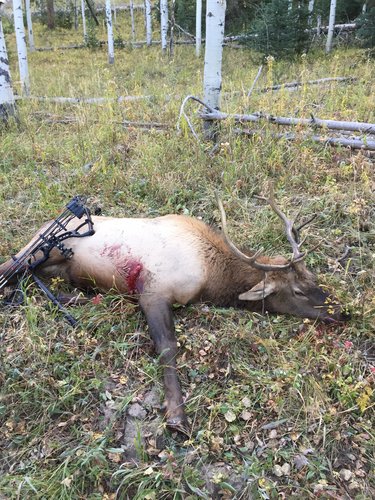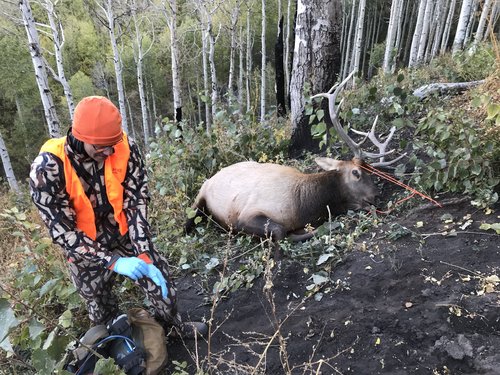Navigation
Install the app
How to install the app on iOS
Follow along with the video below to see how to install our site as a web app on your home screen.
Note: This feature may not be available in some browsers.
More options
You are using an out of date browser. It may not display this or other websites correctly.
You should upgrade or use an alternative browser.
You should upgrade or use an alternative browser.
westbranch
Well-known member
Liver was 3.5 lbs, each scapula was about 1.25 lbs, and I'd guess there was 10 lbs of tallow, so 62 -3.5 -2.5 -10 = 46 lbs. of meat. Mature does in IA are 140-160 lbs off the hoof LINK, which x 0.30 yields 42-48 lbs of meat. This doe was a typical specimen for the area.
We weighed a few big whitetail does from east central MN at 130-135 lbs field dressed on a cheap big game scale. 120 lbs field dressed seemed average for a mature doe in our area. Field dressed for us was heart, lungs, other organs all removed. Head, hide, legs still attached. Some would have a solid 2 inches of fat in some spots on their hindquarters, total weight of the fat on some of those deer would have been interesting. But we usually did not even weigh the processed meat.
Addicting
Well-known member
Not to call anyone out but the 62lbs off a whitetail doe would equal a 186 live weight which seems pushing the envelope, but then if you factor in liver, heart, scapula etc. that normally wouldn't be included say that is 10 pounds. Take that off the 62 pounds gets you to to 52 lbs of boneless meat not counting organs and that gets you up to 156 live weight which seems much more reasonable.
Depending on the area and food sources it is possible. I have 25 years this year of shooting a does here in MI. We weighed a lot of them gutted but otherwise whole. Average here for a mature doe is around 130- 140lbs. We have however had 1 that was 204. However, it was obvious she was a abnormality when one would look at her. That was close to 20 years ago and haven’t had one close since.
WyoDoug
Well-known member
I butcher my own and my actual weight of the meat is less than half of hanging weight. I have never weighed everything as one deboned carcass personally. All I can do is estimate and figure what everything weight individually which is not really accurate. I don't carry that kind of stuff into the field so I have no clue other than what the processor I used to use told me. I know when I was paying a processor, I got less than half of hanging weight back plus added stuff for sausage and that. Now that I do my own, I still get roughly half of hanging weight for actual yield of meat when I am done.
Bambistew
Well-known member
My good friend has killed a couple elk that were around 400lbs of bone in meat. They were mature Roosevelts bulls off Kodiak. I don't recall the exact weight, but it was stupid, and The pictures look like bull moose. He knew the exact weight, because he had to pay by the pound for it to be flown back to Anchorage...
We killed and packed a lot of elk over the years on horses, I don't recall really ever weighing any, some where heavier than others, and the early season bulls where usually considerably heavier than the November bulls. The way we packed them, we split the quarters down the back bone, left the hide intact, and draped them over a saddle. 2 tough guys could lift halves on. Occasionally we needed a come-a-long or pulley to lift it up. The biggest one I killed was 240lbs of cut/wrapped meat picked up from the processor. I don't recall the take in weight. That also included suet to the burger, so maybe 20bs added?
We killed and packed a lot of elk over the years on horses, I don't recall really ever weighing any, some where heavier than others, and the early season bulls where usually considerably heavier than the November bulls. The way we packed them, we split the quarters down the back bone, left the hide intact, and draped them over a saddle. 2 tough guys could lift halves on. Occasionally we needed a come-a-long or pulley to lift it up. The biggest one I killed was 240lbs of cut/wrapped meat picked up from the processor. I don't recall the take in weight. That also included suet to the burger, so maybe 20bs added?
Pucky Freak
Well-known member
I think the 30%-40% guideline, with 30 for smaller species and 40 for larger ones, is actually a reasonably useful starting point for new hunters planning a backpack hunting trip. Next I'd check the G&F data for average mature animals for that area, then take additional subtractions for male animals during or after the rut, as well as any cuts of meat you are (legally) not planning on removing from the field.Definitely and I'm aware of the 30% rule, problem is that data point is totally irrelevant. People are so bad at estimating live weight it makes the whole estimating meat yield look reasonable. To talk to hunters, every spring bear killed in MT this year weighed 400lbs live, when in reality I bet 80% were less than 140lbs, 10% were 150-175lbs, 5% were 175-200lbs, and 5% were above 200lbs.
What I think is way more practical and helpful is a picture of a 5x5 bull saying we packed out 185lbs of meat, a picture of a small 6x6 saying we packed out 190-200lbs of meat, and a picture of a huge monster 7pt bull saying we packed out 235-250lbs of meat. Same for moose, deer, pronghorn, bears, etc.
Also level of meat removal is important, a butcher might get 230lbs off an elk killed with a perfect shot, a veteran elk hunter might get 215lbs, a guy taking just the legal requirements 195, and someone taking that bozo advice from the "shot placement on an elk thread" and blasting a bull through both front shoulders with cheap ammo might only be getting 140-160lbs of meat.
The goal is to give new hunters representative animals and weights from people in the field doing their best butchering, rather than ratios that are impossible to estimate or number that stem from butcher quality processing.
I'll make up an example. Let's say mature elk in a particular area average 700-800 lbs live. Take 800 lbs x .90 for hunting post-rut, so 720 lbs. Let's say you're planning to leave an additional 20 lbs in the field of less desirable cuts. 720 lbs x 0.35 = 252 lbs - 20 lbs = 232 lbs meat absolute maximum you need to be prepared to remove from the field. In reality, the number is almost always going to be significantly less, as most animals will have further deductions due to various factors such as animals taken are not fully mature, damaged meat from injuries/fights/infections/bullets. Just because it's going to be sub 200 lbs much of the time, the important value IMO is planning for the heaviest load.
Thanks for starting a useful thread
D
Deleted member 28227
Guest
The important value IMO is planning for the heaviest load.
100% agree.
HSi-ESi
Well-known member
This has been a good thread. I've always wondered why folks over-estimate - and part of that is surely due to ego. But I think a big part of that is folks just don't know what things weigh, and they've heard stories and are comparing their experience to the story and don't really put much thought into it.
As a kid, we rarely actually weighed anything. I was big into weight-lifting - and always felt I had a "good sense" of what something weighed. The last 10 years or so, I've been weighing game-bags, quarters and whole critters (when possible, minus guts there). My estimates haven't changed much (in many cases my estimates are now higher), but it's helped learn the butchery process (esp. when applied to livestock). A 45 lb quarter doesn't "feel the same" as picking up a 45 lb plate.
I've found the 30-35% rule to be a good indicator.
I like to compare my data to the studies / numbers stated above as much as possible - and to actually have some hard-data when someone throws out some inflated numbers.
As a kid, we rarely actually weighed anything. I was big into weight-lifting - and always felt I had a "good sense" of what something weighed. The last 10 years or so, I've been weighing game-bags, quarters and whole critters (when possible, minus guts there). My estimates haven't changed much (in many cases my estimates are now higher), but it's helped learn the butchery process (esp. when applied to livestock). A 45 lb quarter doesn't "feel the same" as picking up a 45 lb plate.
I've found the 30-35% rule to be a good indicator.
I like to compare my data to the studies / numbers stated above as much as possible - and to actually have some hard-data when someone throws out some inflated numbers.
Bowhuntrben
Well-known member
We have however had 1 that was 204.
I believe this. I don't shoot does very often anymore, but I have seen some that look like bucks they are so big. I remember one in particular that looked like a BIG buck. I would expect she was nearing that range. This is in Minnesota.
Hem
Well-known member
An elk quarter to a horseman is different than a quarter to a foot hunter. One splits the spine and keeps some ribs,the other disconnects at the hip joint.
I packed a bull quarter for a friend yesterday...most people call it 80+lbs.
Probably closer to high 60's low 70's.
But you can boost my ego if you want.
I packed a bull quarter for a friend yesterday...most people call it 80+lbs.
Probably closer to high 60's low 70's.
But you can boost my ego if you want.
D
Deleted member 28227
Guest
An elk quarter to a horseman is different than a quarter to a foot hunter. One splits the spine and keeps some ribs,the other disconnects at the hip joint.
I packed a bull quarter for a friend yesterday...most people call it 80+lbs.
Probably closer to high 60's low 70's.
But you can boost my ego if you want.
A 70lb boned out quarter would have to be a rosie, or a massive BC bull because to be proportional would mean a 280lb boned out elk.
Now 65lb bone in meaning, 53lb boned out would be around 220lb of boned out meat which is right around average.
Which, to your point, it all depends on how you cut the meat and look at the situation.
Last edited by a moderator:
HSi-ESi
Well-known member
Darn-it, there goes my "200 lb" cougar story.
BrentD
Well-known member
And 160 lb wolfDarn-it, there goes my "200 lb" cougar story.
COEngineer
Well-known member
- Joined
- Jul 6, 2016
- Messages
- 1,619
I used a bathroom scale and recorded these numbers (quarters were bone-in) from a nice 6x6 taken in southern CO in 2018:
front qtr 48 lbs
front qtr with backstraps and misc 59 lbs
rear qtr (each, x2) 61 lbs
Total: 229 lbs
We weighed the bones after butchering at 26 lbs total and that was after they were very well cleaned. We certainly left some neck and flank meat on the mountain because we were under the gun due to warm temps (we were worried about spoilage and bugs) and had to haul it on our backs 6 miles one way to the truck. I imagine we could have gotten another ~20 lbs of meat if we had had more time and/or cooler temps.
front qtr 48 lbs
front qtr with backstraps and misc 59 lbs
rear qtr (each, x2) 61 lbs
Total: 229 lbs
We weighed the bones after butchering at 26 lbs total and that was after they were very well cleaned. We certainly left some neck and flank meat on the mountain because we were under the gun due to warm temps (we were worried about spoilage and bugs) and had to haul it on our backs 6 miles one way to the truck. I imagine we could have gotten another ~20 lbs of meat if we had had more time and/or cooler temps.
KipCarson
Well-known member
For several years back in my college days I worked at a meat processor. It was all whitetails and wild hogs. It was always funny to me, and infuriating, the number of people who thought they were getting cheated when they only ended up with one box of meat off of a 120 lb whitetail doe. “Look sir, by the time you throw away the guts, hide, hooves, head, and bone, and I trim out the ruined stuff because of your crappy gut shot, all that is left on a deer that size is 35 pounds of meat if you were lucky!” I’m liking this this thread, good to see guys keeping it real, If you want to get into exaggerations, start asking the guys down south about the size hogs they kill! (insert eye roll here)
elkrchr
Well-known member
I weighed my last sitka blacktail deer (2015) taken from Kodiak Island upon our arrival back in town. Minus the 5-gallon pail weight and factoring in we ate the tenderloins at camp, I had 72 pounds of boneless meat.
LuketheDog
Well-known member
R
rwc101
Guest
I took the backstraps, neck, and tenderloins

LuketheDog
Well-known member
Similar threads
- Replies
- 20
- Views
- 2K






